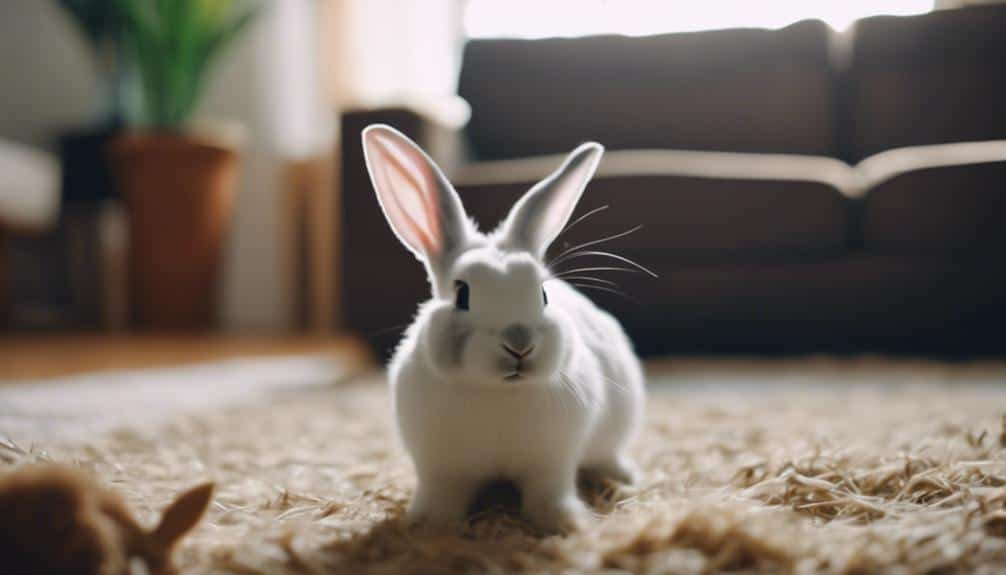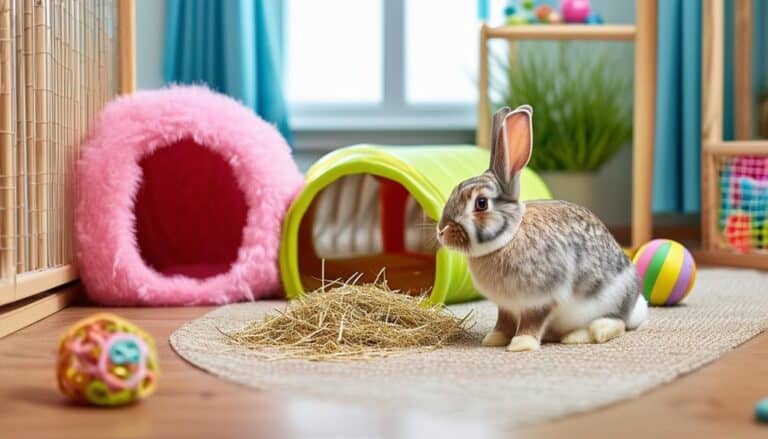Understanding Pet Rabbit Behavior: A Comprehensive Guide
When you bring a rabbit into your home, understanding its behavior becomes essential for fostering a positive relationship. You’ll need to create a rabbit-friendly environment, which includes providing hiding spots and enrichment activities to keep your furry friend engaged.
Recognizing and interpreting rabbit body language can help you address any issues before they escalate. But how do you handle aggressive behavior, and what role do diet and exercise play in your rabbit’s well-being? By exploring these aspects, you’ll be better equipped to nurture a strong, trust-based bond with your pet rabbit.
Setting Up a Rabbit-Friendly Environment
To create a rabbit-friendly environment, provide hiding spots like tunnels or boxes to help them feel secure. This setup is important for house rabbits, as they need spaces that mimic their natural habitats. Rabbits use these hiding spots to retreat when they feel threatened or stressed, which is a significant aspect of their body language.
Enrichment is essential to prevent boredom and stimulate activity. Offer a variety of toys and objects, such as cardboard boxes and chewable items like apple wood sticks. These items not only engage their minds but also help maintain dental health. You’ll notice that your rabbit might chew on various objects; providing safe alternatives redirects this behavior appropriately.
A spacious enclosure is necessary for promoting physical activity. Ensure the enclosure has ample room for hopping and stretching, as this helps in maintaining their physical health and well-being. Additionally, litter training is an integral part of keeping house rabbits as pets. Provide an easily accessible litter box to guarantee proper hygiene.
Rabbits are known to mark their territory, so expect them to leave scent marks around the enclosure. Understanding these behaviors is critical in creating a conducive environment for your rabbit.
Decoding Rabbit Body Language
Understanding rabbit body language is crucial for comprehending their emotional and physical states, enabling better care and interaction. When you decode rabbit behavior, you can identify when your pet is happy, fearful, or seeking attention. Rabbits’ body language includes various signals that indicate their mood and needs.
For instance, gentle nudges are a sign of affection and trust-building. If your rabbit nudges you, they’re engaging in a social interaction that strengthens your bond.
In contrast, flattening their body against the ground often signifies submission or fear, especially in social scenarios involving other rabbits. This body language indicates that your rabbit feels threatened or submissive.
Observing your rabbit’s ears can also provide significant insights; ears held forward with high alertness suggest that your rabbit is highly attentive and possibly sensing danger.
Moreover, you might notice butt twitching while eating, which is an indicator of extreme happiness and contentment. Finally, nipping behavior can be perplexing but is generally used to gain attention or as part of grooming activities.
Common Rabbit Behaviors
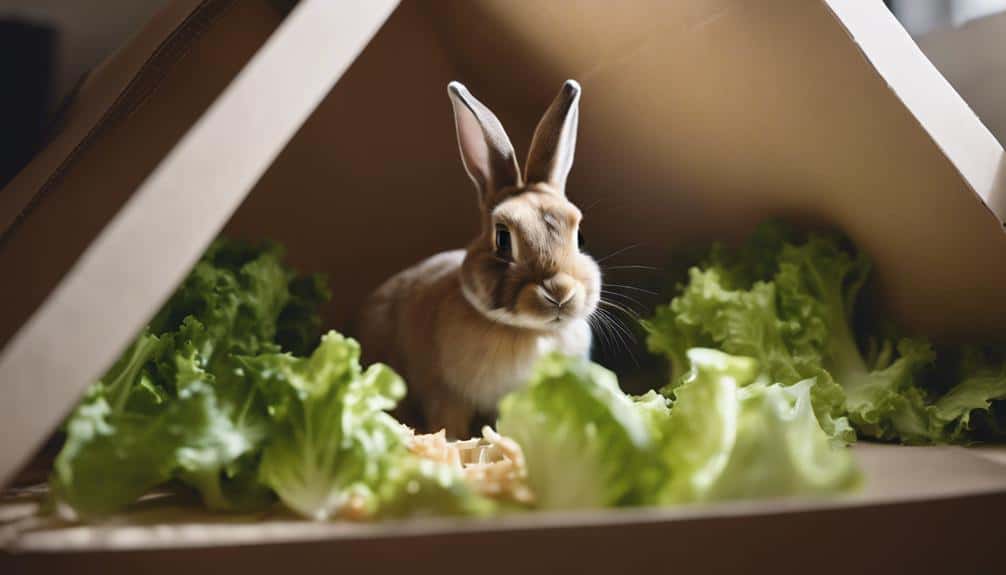
You’ll notice your rabbit engaging in various behaviors that communicate different emotions and needs. Thumping and stomping typically indicate alarm or distress, while binkies and zoomies show exuberant happiness.
Chinning and marking are territorial actions that help your rabbit establish its domain.
Thumping and Stomping
Rabbits often engage in thumping and stomping as an instinctive response to perceived threats or discomfort in their environment. When a rabbit thumps, it’s using its hind legs to communicate a warning about potential danger. This act serves as a signal to other rabbits in the vicinity, alerting them to be cautious.
Stomping, on the other hand, involves a more forceful and repetitive action, often expressing the rabbit’s unease or displeasure. Understanding these behaviors allows you, as a rabbit owner, to interpret your pet’s feelings accurately.
Common triggers for thumping and stomping include:
- Loud Noises: Sudden sounds can startle rabbits, causing them to thump as a defense mechanism.
- Sudden Movements: Unpredictable motions in their environment can lead to a rabbit stomping to express its discomfort.
- Unfamiliar Scents: New smells can be perceived as threats, prompting thumping behavior.
Binkies and Zoomies
Binkies, characterized by high jumps and mid-air twists, signify a rabbit’s extreme happiness and are commonly observed during periods of exercise. This behavior is a clear indicator of your rabbit’s joy and well-being. When a rabbit performs a binky, it’s expressing exuberance and contentment, often seen in an environment where it feels safe and stimulated.
Following binkies, you’ll often observe zoomies, which involve high-speed running around the space in excitement. Zoomies are another manifestation of pure happiness and are typically exhibited just after a series of binkies. These rapid movements highlight the rabbit’s need for exercise and freedom, reflecting its overall physical and emotional health.
Not all rabbits will display binkies or zoomies. Variations in personality or physical limitations can influence this behavior. However, the presence of these behaviors in your rabbit is a positive sign of its joy and satisfaction with its living conditions.
Pay attention to how frequently your rabbit engages in binkies and zoomies as an analytical measure of its happiness. Encouraging an environment that promotes these behaviors can greatly enhance your rabbit’s quality of life, ensuring it remains a joyful and content companion.
Chinning and Marking
While binkies and zoomies display a rabbit’s joy, chinning and marking behaviors serve as mechanisms for territorial establishment and communication. Chinning involves a rabbit rubbing its chin on objects to mark its territory using scent glands located under the chin. This behavior is vital for rabbits to establish ownership and create a familiar environment.
By chinning various objects, your rabbit is effectively saying, ‘This is mine.’ This behavior helps them feel secure and communicate with other rabbits. You’ll often observe rabbits chinning their favorite spots and toys. Male rabbits, in particular, exhibit chinning more frequently than females, as it serves as a method for asserting dominance.
Key points to understand about chinning and marking:
- Territory Establishment: Chinning allows rabbits to mark their environment, providing a sense of security.
- Communication: The scent left by chinning acts as a message to other rabbits about ownership and presence.
- Natural Instinct: Both wild and domestic rabbits engage in chinning as part of their inherent behaviors.
Understanding this behavior can help you better manage your rabbit’s environment, ensuring they feel secure and understood. By recognizing these actions, you can create a more harmonious living space for your pet.
Understanding Communication Cues
Recognizing and interpreting your rabbit’s communication cues, such as ear positions and body posture, is essential for understanding their needs and emotions. As rabbit owners, comprehending these subtle signals helps you better understand your rabbit’s natural behaviors. Pet rabbits use various non-verbal cues to express themselves, which can greatly enhance your ability to care for them effectively.
Understanding these signals involves paying close attention to key indicators:
| Communication Cue | Meaning |
|---|---|
| Ear Positions | Alert, relaxed, or scared |
| Body Posture | Aggressive, submissive, or content |
| Tail Movements | Agitation or excitement |
| Thumping | Warning or distress |
| Grooming | Affection or self-care |
For instance, ears pointing forward typically indicate curiosity, while flattened ears signify fear. A relaxed body posture suggests a content rabbit, whereas a tense stance might indicate aggression or discomfort. Thumping is often a sign of distress or a warning, while grooming can indicate affection or self-maintenance.
Paying attention to these cues allows you to respond appropriately, meeting your rabbit’s needs and preventing misunderstandings. This understanding fosters a stronger bond between you and your pet rabbit, ensuring a harmonious and fulfilling relationship. By observing and interpreting these natural behaviors, you can create a more responsive and empathetic environment for your rabbit.
Handling Aggressive Behavior
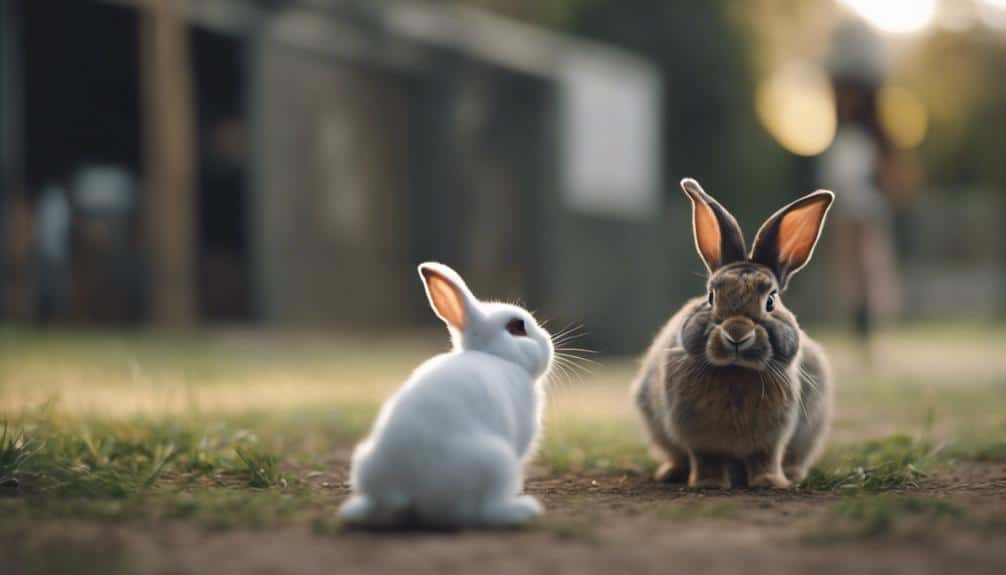
After understanding your rabbit’s communication cues, it’s important to address aggressive behavior that may arise from fear, stress, pain, or territorial instincts. Recognizing the signs of aggression—such as growling, lunging, biting, boxing, and thumping—is vital for effective management.
To manage aggressive behavior, consider the following steps:
- Socialization and Environmental Enrichment: Gradually introduce your rabbit to new environments and experiences to reduce fear and stress. Provide ample space, toys, and hiding spots to keep them mentally stimulated.
- Positive Reinforcement Training: Reward your rabbit for calm behavior with treats and praise. Avoid punishing aggressive actions as this can exacerbate fear and stress.
- Neutering/Spaying: Hormones can play a significant role in aggressive behavior, particularly in males. Neutering or spaying can often reduce these tendencies, making your rabbit calmer and more sociable.
If aggression persists despite these interventions, seek advice from a rabbit-savvy veterinarian or animal behaviorist. They can provide tailored strategies and check for underlying health issues contributing to the behavior.
The Role of Diet and Exercise
Ensuring your rabbit has a balanced diet and adequate exercise is essential for maintaining peak health and well-being. A diet rich in hay, fresh vegetables, and limited pellets is crucial for optimal digestive health. Hay should constitute the majority of their diet, promoting proper digestion and preventing dental issues.
Fresh vegetables provide necessary vitamins and minerals, while pellets should be limited to avoid excess calorie intake.
Exercise is equally important for preventing obesity and ensuring mental and physical stimulation. Aim for at least 3-4 hours of supervised playtime in a safe area daily. This can include providing chew toys, tunnels, and agility courses, which cater to a rabbit’s natural instincts for exploration and activity.
Monitoring their activity level and adjusting food portions accordingly is vital. An active rabbit will require more calories than a sedentary one.
Hydration is another crucial aspect. Fresh water should always be available, and you should regularly check to ensure your rabbit is drinking adequately.
Recognizing Health Issues
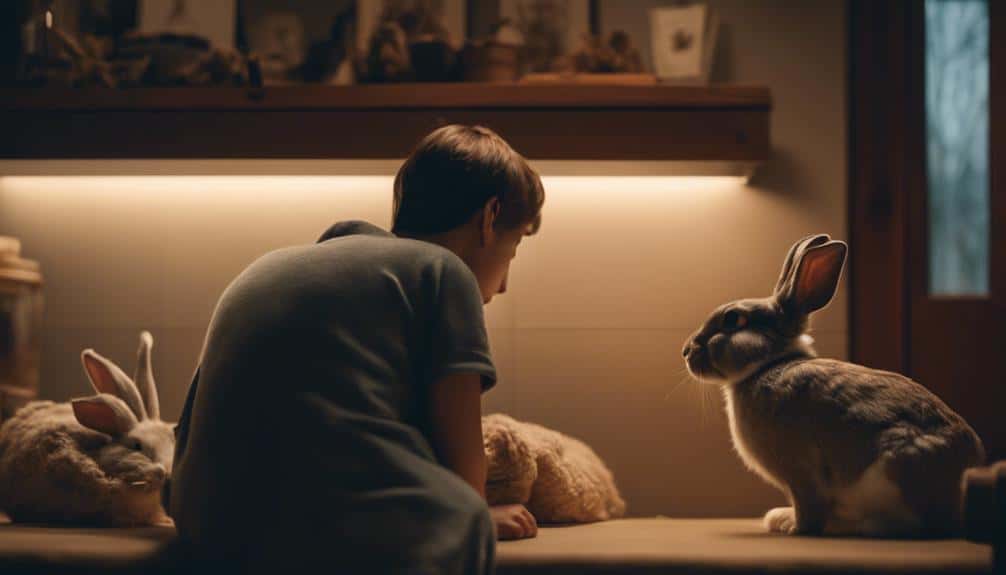
Sudden changes in your rabbit’s behavior can be critical indicators of underlying health issues that demand immediate attention. As a responsible owner, you must be vigilant in monitoring these changes to guarantee the well-being of your house rabbits. Behavioral shifts can indicate pain or other health concerns that, if left unaddressed, could become serious.
Key health issues to watch for include:
- Dehydration: A rabbit that isn’t drinking enough or shows signs of lethargy may be dehydrated. Check their water supply and make sure it’s clean and accessible.
- Gastrointestinal problems: Lack of appetite or changes in stool consistency, such as fewer firm pellets and more loose caecotrophs, can signify digestive issues. Rabbits need a high-fiber diet to maintain healthy digestion.
- Lack of exercise: Inadequate exercise can lead to obesity and related health concerns. Ensure your rabbit has ample space and opportunities to move around.
Additionally, properly trained rabbits using litter boxes can help you monitor their waste output more effectively, providing early clues to potential health issues.
Neutering, particularly in male rabbits, can prevent urine spraying and contribute to overall health, reducing stress and behavioral problems.
Stay proactive in your rabbit care to maintain their health and happiness.
Building Trust and Bonding
To build trust and bond with your rabbit, utilize positive reinforcement techniques such as treats and praise during interactions. Implement safe interaction strategies by maintaining a calm demeanor and respecting your rabbit’s space and boundaries. These methods foster a secure environment, essential for developing a strong, trusting relationship.
Positive Reinforcement Techniques
Utilizing positive reinforcement techniques, such as rewarding desired behaviors with treats or praise, is crucial for building trust and bonding with your pet rabbit. When you reward your rabbit for specific actions, you’re not only reinforcing good behaviors but also creating a positive association with you. This method is both effective and humane, promoting a cooperative and affectionate relationship.
To optimize the use of positive reinforcement techniques, follow these steps:
- Consistency: Make sure that you consistently reward the desired behaviors. Inconsistent reinforcement can confuse your rabbit and impede progress.
- Timing: Deliver rewards immediately after the desired behavior. Delayed rewards can weaken the association between the action and the reward.
- Patience: Building trust and shaping behaviors takes time. Be patient and avoid rushing the process.
Incorporating clicker training or consistent vocal cues paired with treats can further enhance these techniques. For example, using a clicker when your rabbit approaches you or uses the litter box can solidify these positive behaviors. Over time, your rabbit will associate the sound or word with a reward, fostering trust and a deeper connection.
Safe Interaction Strategies
Establishing safe interaction strategies with your pet rabbit is essential for building trust and fostering a strong bond. Begin by observing your rabbit’s behavior closely. If your rabbit seems hesitant, it’s letting you know it needs more time to feel secure. Approach gently, offering gentle nudges to indicate your desire for interaction. This means your rabbit can gradually adjust to your presence without feeling threatened.
Offering treats is a powerful tool. Positive reinforcement during interactions not only encourages desired behaviors but also strengthens your bond. Always have a place to hide available for your rabbit. This guarantees it has a safe retreat, which is critical for its sense of security.
Consistently spend quality time with your rabbit. Engage in grooming, petting, and playtime activities. These interactions are essential for deepening your bond. Patience and consistency are key; your rabbit needs to feel safe and secure over time to fully trust you.
Respect your rabbit’s boundaries. Pay attention to body language cues, such as turning away or thumping, indicating discomfort. Understanding and respecting these signals will ensure a positive, trusting relationship.
Conclusion
By understanding your rabbit’s behavior, you can establish an environment where they thrive. Focus on setting up a rabbit-friendly space, decoding their body language, and recognizing common behaviors.
Guarantee their diet and exercise needs are met, and monitor their health closely. Address any aggressive behavior with positive reinforcement and patience.
Building trust through mutual respect will strengthen your bond, securing a happy and healthy relationship with your pet rabbit.

